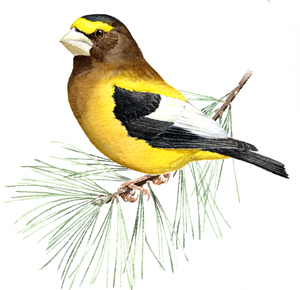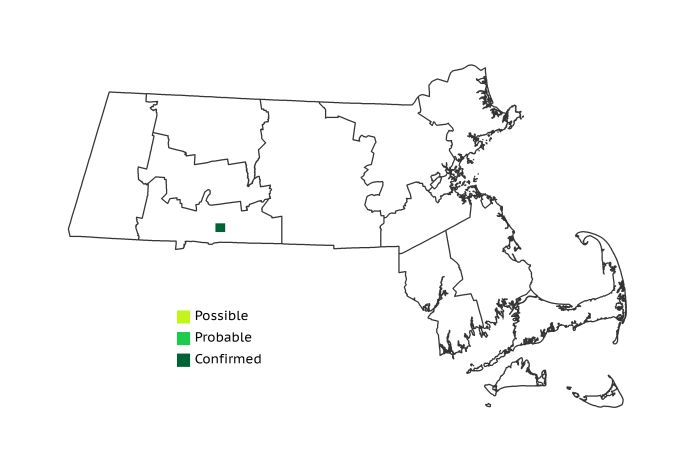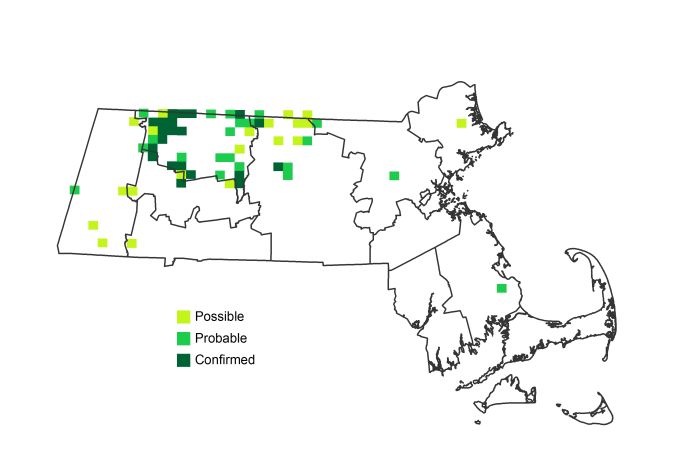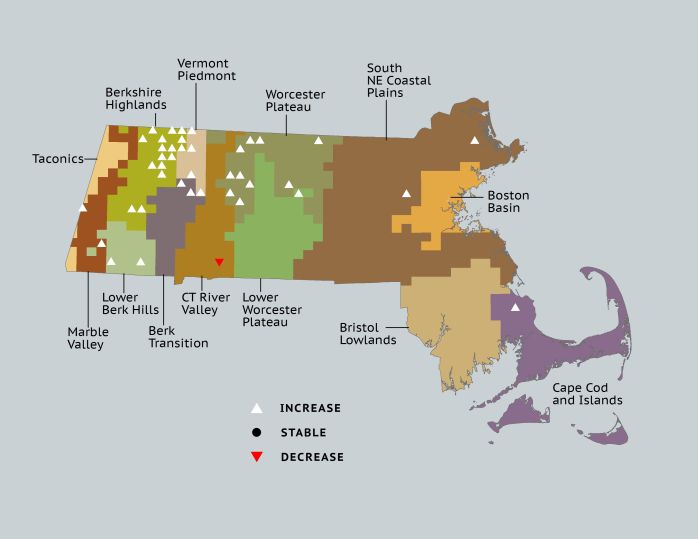Find a Bird
Evening Grosbeak
Coccothraustes vespertinus

Local and strongly increasing
“A bird of the most distinguished appearance, indeed, is the Evening Grosbeak, whose very name of ‘Vesper-voiced’ suggests at once the far-away land of the dipping sun…” – Elliott Coues
Although the Evening Grosbeak may occasionally be seen in the late afternoon hours, this species is actually most active during the early morning. Its name stems from an early encounter with the bird in 1823 by a Major Delafield, an agent of US boundaries, who disturbed a roosting flock while setting up his evening encampment (Bent 1968). A large and handsome finch, the Evening Grosbeak has expanded its breeding range considerably in the past 150 years. Initially a well-known patron of winter bird feeders across the state, this species is now also finding a foothold as a breeding bird in the Commonwealth.
Historic Status
The Evening Grosbeak, once only a dweller of the Pacific Northwest, first shocked Massachusetts bird observers during a winter invasion in 1889 and 1890, the species having never been seen previously in the state (Howe & Allen 1901). Infrequent sightings occurred during the next two decades until a second major invasion occurred in the winter of 1910 and 1911 (Forbush 1929). Thereafter, the species became a regular winter visitor in varying numbers to Massachusetts. Summer observations also occurred in a handful of communities from 1923 onward, and the first breeding discovery was made in 1958. The previous winter witnessed a tremendous flight of this species to the Bay State, and lingerers were reported throughout May and June. In July 1958, a female was observed feeding a youngster in Hadley (Stackpole & Emery 1958).
Atlas 1 Distribution
Despite the 1958 record listed above, Evening Grosbeaks remained scarce as a breeding species in Massachusetts during Atlas 1. The only sign of breeding during Atlas 1 was a female constructing a nest in West Springfield in the Connecticut River Valley. Sadly, the pair apparently abandoned the area without laying eggs or raising a brood of chicks, so the discovery of a nest with eggs or young (which would be a state first) would have to be indefinitely postponed.
Atlas 2 Distribution and Change
Even though birdwatchers are well known prognosticators who seem to enjoy guessing which rare bird will be the next to appear on their state list, or which species appears to be increasing or decreasing, few predicted the large-scale increase of the Evening Grosbeak’s breeding population that would be detected in the Commonwealth during Atlas 2. The current distribution of this species shows it occupying about 30% of the Berkshire Highlands, Vermont Piedmont, and Worcester Plateau, with sporadic reports elsewhere. This increase from Atlas 1 is impressive, and curiously is not reflected in nearby states.
Atlas 1 Map

Atlas 2 Map

Atlas Change Map

Ecoregion Data
Atlas 1 | Atlas 2 | Change | ||||||
Ecoregion | # Blocks | % Blocks | % of Range | # Blocks | % Blocks | % of Range | Change in # Blocks | Change in % Blocks |
Taconic Mountains | 0 | 0.0 | 0.0 | 0 | 0.0 | 0.0 | 0 | 0.0 |
Marble Valleys/Housatonic Valley | 0 | 0.0 | 0.0 | 2 | 5.1 | 3.2 | 2 | 5.1 |
Berkshire Highlands | 0 | 0.0 | 0.0 | 17 | 30.9 | 27.4 | 16 | 30.2 |
Lower Berkshire Hills | 0 | 0.0 | 0.0 | 2 | 6.5 | 3.2 | 2 | 7.4 |
Vermont Piedmont | 0 | 0.0 | 0.0 | 5 | 29.4 | 8.1 | 4 | 33.3 |
Berkshire Transition | 0 | 0.0 | 0.0 | 4 | 10.0 | 6.5 | 2 | 6.5 |
Connecticut River Valley | 1 | 1.8 | 100.0 | 1 | 1.5 | 1.6 | -1 | -2.1 |
Worcester Plateau | 0 | 0.0 | 0.0 | 27 | 30.7 | 43.5 | 10 | 20.8 |
Lower Worcester Plateau | 0 | 0.0 | 0.0 | 1 | 1.3 | 1.6 | 1 | 1.9 |
S. New England Coastal Plains and Hills | 0 | 0.0 | 0.0 | 2 | 0.7 | 3.2 | 2 | 0.9 |
Boston Basin | 0 | 0.0 | 0.0 | 0 | 0.0 | 0.0 | 0 | 0.0 |
Bristol and Narragansett Lowlands | 0 | 0.0 | 0.0 | 0 | 0.0 | 0.0 | 0 | 0.0 |
Cape Cod and Islands | 0 | 0.0 | 0.0 | 1 | 0.7 | 1.6 | 1 | 0.8 |
Statewide Total | 1 | 0.1 | 100.0 | 62 | 6.0 | 100.0 | 39 | 4.7 |
Notes
The Evening Grosbeak shows a significant decreasing Breeding Bird Survey trend in the Eastern US overall. Massachusetts found Evening Grosbeaks on too few routes for a significant result, but in New Hampshire there are many Breeding Bird Survey routes recording Evening Grosbeaks, and these routes are showing a significant increase in abundance since 1966.



